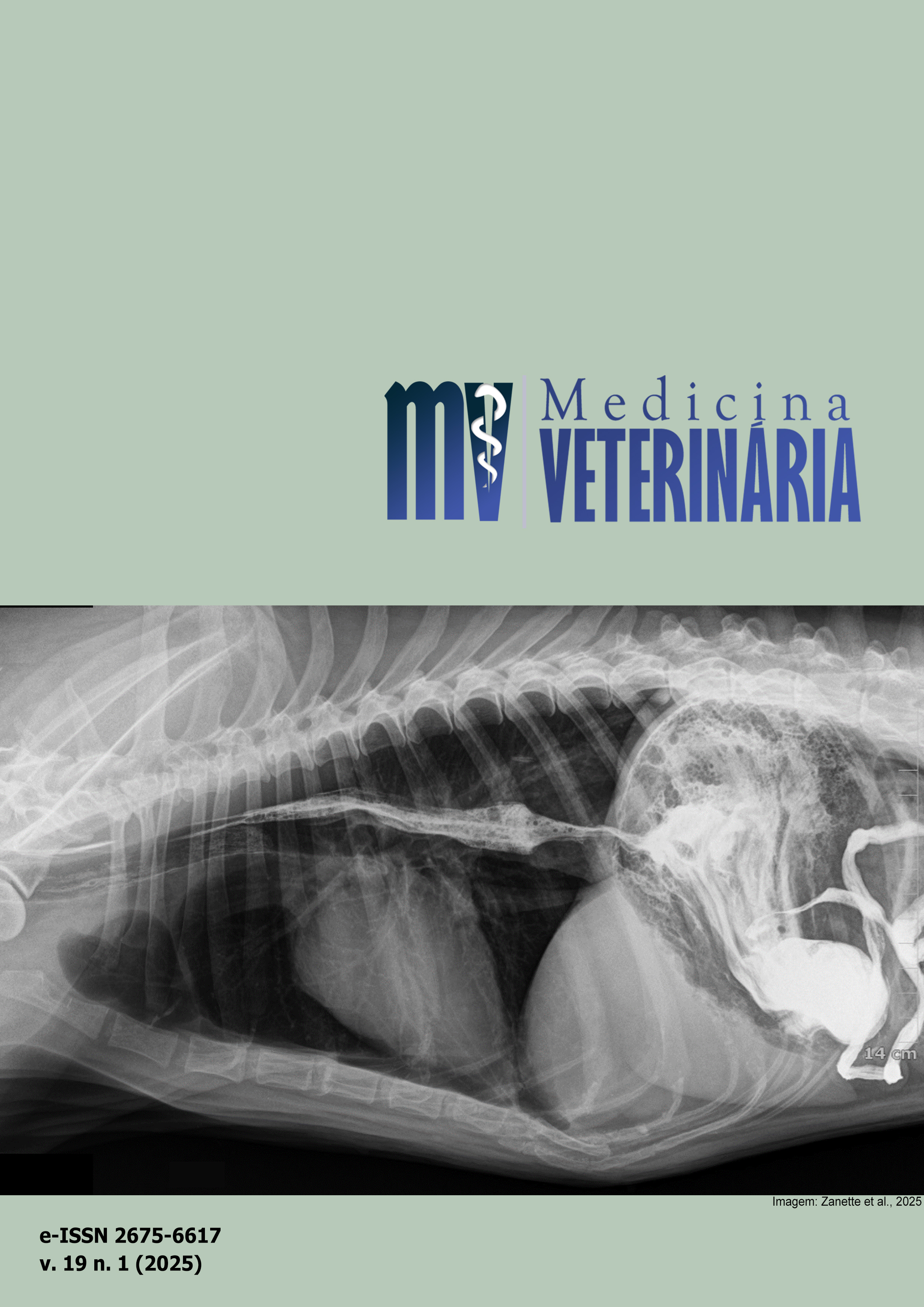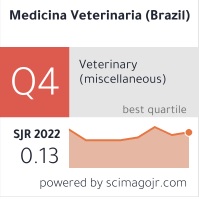Rupturas simultâneas do ligamento palmar do carpo e do tendão flexor digital superficial em um cavalo de tração
DOI:
https://doi.org/10.26605/medvet-v19n1-6892Palavras-chave:
ortopedia equina, casos clínicos, sistema locomotor, membros torácicosResumo
Este relato descreveu o caso clínico de um cavalo castrado, com aproximadamente 13 anos de idade, sem raça definida, com rupturas concomitantes nos membros torácicos, incluindo ligamento carpal palmar esquerdo e tendão flexor digital superficial direito. Após o exame clínico, observou-se intensa hiperextensão na articulação do carpo e edema, calor e dor intensa em ambos os membros torácicos, além de relutância em movimentar-se e grave grau de claudicação. No exame radiográfico, o membro torácico direito apresentava hiperextensão da articulação radiocárpica com 225° e presença de subluxação lateral do osso carpo-ulnar e o membro torácico esquerdo apresentava hiperextensão da mesma articulação com ângulo de 235°. Após a eutanásia, foi observada ruptura multifocal parcial do ligamento palmar do carpo no membro torácico esquerdo e ruptura total do tendão flexor digital superficial no membro torácico direito. Este estudo apresentou o caso e discutiu as possíveis causas da ocorrência de rupturas concorrentes. Além disso, o relato explorou a hiperextensão do carpo equino, uma condição rara com registros de recuperação limitados após lesões por ruptura do ligamento carpal palmar. Enfatiza o papel biomecânico deste ligamento e sua sinergia com o tendão flexor digital superficial na prevenção da hiperextensão. Embora as rupturas de tendões tenham opções de tratamento, a ruptura completa do ligamento palmar do carpo muitas vezes leva à eutanásia devido a danos articulares irreparáveis.Downloads
Referências
Amaral, L.A.; Rabassa, V.; Marchiori, M.; Meirelles, M.; Amado, M.; Nogueira, C.E.W. Use of lidocaine hydrochloride 2% intrathecally associated with prior anesthesia with thiopental as a method of euthanasia in horses. Ars Veterinaria, 27(1): 011-016, 2011.
Back, W.; Barneveld, A.; Van Weeren, P.R.; Van Den Bogert, A.J. Kinematic gait analysis in equine carpal lameness. Acta Anatomica (Basel), 146: 86–89, 1993.
Barba, M.; McMaster, M.; Albanese, V.; Cole, R.; Caldwell, F.; Schumacher, J. Carpal hyperextension in a Percheron mare caused by a palmar carpal ligament tear. Equine Veterinary Education, 26(7): 347-352, 2014.
Barr, A.R. Carpal conformation in relation to carpal chip fracture..Veterinary Record, 134: 646-650, 1994.
Biewener, A.A. Muscle-tendon stresses and elastic energy storage during locomotion in the horse. Comparative Biochemistry & Physiology Part B: Biochemical and Molecular Biology, 120(1), 73–87, 1998.
Bonilla-Gutiérrez, A.F.; López, C.; Carmona, J.U. Regenerative therapies for the treatment of tenodesmic injuries in horses. Journal of Equine Veterinary Science, 73: 139-147, 2019.
Burn, J.F.; Portus, B.; Brockington, C. The effect of speed and gradient on hyperextension of the equine carpus. The Veterinary Journal, 171: 169-171, 2006.
Carazzato, J.G. Lesões musculotendíneas e seu tratamento. Revista Brasileira de Ortopedia, 29(10): 723-728, 1994.
Clayton, H.M.; Schamhardt, H.C.; Willemen, M.A.; Lanovaz, J.L.; Colborne, G.R. Kinematics and ground reaction forces in horses with superficial digital flexor tendinitis. American Journal of Veterinary Research, 61: 191–196, 2000.
Dahlgren, L.A. Pathobiology of tendon and ligament injuries. Clinical Techniques in Equine Practice, 6(3): 168-173, 2007.
Davankar, S.P.; Deane, N.J.; Davies, A.S.; Firth, E.C.; Hodge, H.; Parry, D.A.D. Collagen fibril diameter distributions in ligaments and tendons of the carpal region of the horse. Connective Tissue Research, 34(1): 11-21, 1996.
De Filippo, M.; Sudberry, J. J.; Lombardo, E.; Corradi, M.; Pogliacomi, F.; Ferrari, F. S.; Bocchi, C.; Zompatori, M. Pathogenesis and evolution of carpal instability: imaging and topography. Acta Biomedica, 77(3): 168-180, 2006.
Denoix, J.M. Functional anatomy of tendon and ligaments in the distal limbs (manus and pes). The Veterinary Clinics of North America: Equine Practice, 10(2) 273-322, 1994.
Denoix, J.M. Biomechanics and physical training of the horse. 1st ed. Boca Raton: CRC Press, 2014. 192p.
Dyce, K.M.; Sack, W.O.; Wensing, C.J.G. Textbook of veterinary anatomy. Philadelphia: W. B. Saunders Company, 1987. p.554-567.
Engiles, J.B.; Stewart, H.; Janes, J.; Kennedy, L.A. A diagnostic pathologist's guide to carpal disease in racehorses. Journal of Veterinary Diagnostic Investigation, 29(4): 414-430, 2017.
Evans, D.L. Physiology of equine performance and associated tests of function. Equine Veterinary Journal, 39(4): 373-383, 2007.
FAWC. Farm Animal Welfare Committee. Opinion on the welfare of animals killed on-farm. 2017. Available at: . Accessed on: 24 jan. 2022.
Getty, R. Sisson and Grossman's The Anatomy of the Domestic Animals. Vol 1. 5th ed. Philadelphia: Saunders, 1975. 1286p.
Jorgensen, J.S.; Genovese, R.L. Superficial digital flexor tendonitis. In: Ross, M.W.; Dyson, S.J. (Eds). Diagnosis and Management of Lameness in the Horse. 1st ed. St Louis: W.B. Saunders, 2003. p.628-642.
Lam, K.K.H. Comparative epidemiology of tendon injuries in different racing disciplines. The Veterinary Journal, 195(3): 265-266, 2012.
Nagy, A.; Dyson, S. The challenge of diagnosing soft tissue injuries in the palmar aspect of the carpus. Equine Veterinary Education, 26(7): 353-356, 2014.
Palmer, S.; Barlow, D.; Ji-Chun, X. Kinematics of the Equine Carpus. In: Gillespie, J.R.; Robinson, N.E. (Eds). Equine Exercise Physiology 2. Davis, CA: ICEEP Publications, 1987. p.599-606.
Patterson-Kane, J.C.; Rich, T. Achilles tendon injuries in elite athletes: lessons in pathophysiology from their equine counterparts. ILAR Journal, 55(1): 86-99, 2014.
Pepe, M.; Beccati, F.; Gialletti, R.; Moriconi, F. Bilateral rupture of the palmar carpal ligament in a horse suffering from acute diaphragmatic hernia. Journal of Equine Veterinary Science, 33(1): 57-61, 2013.
Piermattei, D.L.; Flo, G.L.; DeCamp, C E. Fractures and other orthopedic conditions of the carpus, metacarpus, and phalanges. In: ____. Brinker, Piermattei and Flo’s handbook of small animal orthopedics and fracture repair. 4th ed. St. Louis, Missouri: Saunders Elsevier, 2006. p.382-428.
Schade, J.; Baldissera, R.; Paolini, E.; Fonteque, J.H. Biometria do equilíbrio podal em equinos de tração pertencentes ao Programa de Extensão “Amigo do Carroceiro” do Centro de Ciências Agroveterinárias da Universidade do Estado de Santa Catarina no município de Lages/SC, Brasil. Ciência Rural, 43(3): 456-461, 2013.
Segat, H.J.; Braga, D.N.; Samoel, G.V.A.; Porto, I.P.Ó.; Weiblen, C.; Rodrigues, F.S.; Vogel, F.S.F.; Pereira, D.I.B.; Sangioni, L.A.; Botton, S.A. Equinos Urbanos de Tração: Interação Social, Sanidade e Bem Estar Animal. Investigação, 15(4): 71-76, 2016.
Serra Bragança, F.M.; Hernlund, E.; Thomsen, M.H.; Waldern, N.M.; Rhodin, M.; Byström, A.; van Weeren, P.R.; Weishaupt, M.A. Adaptation strategies of horses with induced forelimb lameness walking on a treadmill. Equine Veterinary Journal, 53(3): 600-611, 2021.
Smith, L.J.; Mair, T.S. Rupture of the superficial flexor tendon in the forelimb in aged horses: a report of nine cases. Equine Veterinary Education, 19(4): 183-186, 2007.
Smith, M.A.; Dyson, S.J.; Murray, R.C. The appearance of the equine metacarpophalangeal region on high?field vs. standing low?field magnetic resonance imaging. Veterinary Radiology & Ultrasound, 52(1): 61-70, 2011.
Whitlock, D.; Garcia, T.C.; Vallance, S.A.; Stover, S.M. Possible role of carpal hyperextension in superficial digital flexor tendinopathy. Equine Veterinary Journal, 44: 559-563, 2012.
Whitton, R.C.; Rose, R.J. The intercarpal ligaments of the equine midcarpal joint, part 2: the role of the palmar intercarpal ligaments in the restraint of dorsal displacement of the proximal row of carpal bones. Veterinary Surgery, 26(5): 367-373, 1997.
Downloads
Publicado
Como Citar
Edição
Seção
Licença
Copyright (c) 2025 Gino Luigi Bonilla Lemos Pizzi; Roberta Blake; Daniel Henrique Vieira Cavalcante, Karina Holz, Leandro Américo Rafael, Charles Ferreira Martins

Este trabalho está licenciado sob uma licença Creative Commons Attribution-NonCommercial-ShareAlike 4.0 International License.
- A Revista de Medicina Veterinária permite que o autor retenha os direitos de publicação sem restrições, utilizando para tal a licença Creative Commons CC BY-NC-SA 4.0.
- De acordo com os termos seguintes:
- Atribuição — Você deve dar o crédito apropriado, prover um link para a licença e indicar se mudanças foram feitas. Você deve fazê-lo em qualquer circunstância razoável, mas de nenhuma maneira que sugira que o licenciante apoia você ou o seu uso.
- NãoComercial — Você não pode usar o material para fins comerciais.
- CompartilhaIgual — Se você remixar, transformar, ou criar a partir do material, tem de distribuir as suas contribuições sob a mesma licença que o original.
- Sem restrições adicionais — Você não pode aplicar termos jurídicos ou medidas de caráter tecnológico que restrinjam legalmente outros de fazerem algo que a licença permita.










